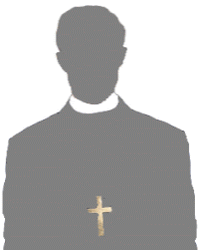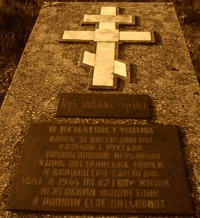Roman Catholic
St Sigismund parish
05-507 Słomczyn
85 Wiślana Str.
Konstancin deanery
Warsaw archdiocese, Poland
full list:
displayClick to display full list

searchClick to search full list by categories
wyświetlKliknij by wyświetlić pełną listę po polsku

szukajKliknij by przeszukać listę wg kategorii po polsku

Martyrology of the clergy — Poland
XX century (1914 – 1989)
personal data

surname
HUDYMA
forename(s)
Ignatius (pl. Ignacy)
function
presbiter (i.e. iereus)
creed
Eastern Orthodox Church ORmore on
en.wikipedia.org
[access: 2014.09.21]
nationality
Ruthene
date and place
of death
1944

Ditkivtsitoday: Brody urban hrom., Zolochiv rai., Lviv obl., Ukraine
more on
uk.wikipedia.org
[access: 2023.03.02]
alt. dates and places
of death
1941
details of death
Arrested by the Austrians on 28.03.1912, together with Fr Maxim Sandowicz. Jailed in Lviv prison and accused of spying for Moscow. Put on trial in Lviv, but acquitted on 06.06.1914 (by a jury composed only of Poles).
After the outbreak of World War I, arrested again by the Austro–Hungarian authorities in 08.1914. Imprisoned in Brody, where was kept in prison until the beginning of the Russian occupation — as a result of Russia's initial successes in the war with Austria–Hungary.
After the Russian defeat in the Battle of Gorlice in 05.1915, did not escape from Galicia with thousands of Russian refugees (so‐called bezhenstvo) — his wife and child escaped east.
After the victorious Austro–Hungarian troops entered, detained again. Being led by gendarmes through the streets of Lviv, attacked by an angry crowd and beaten. Declared dead, taken to the mortuary, where regained consciousness.
Imprisoned in Weinburg and then in the IL Talerhof internment camp (where his father died).
Became mentally ill and was released in 1917.
Returned to his native Ditkivtsi, where lived alone in a half–destroyed cottage. Regarded as „fool for Christ”by the Orthodox.
Murdered by the Germans during World War II, in unknown circumstances — prob. considered mentally ill.
cause of death
murder
perpetrators
Germans
sites and events
«Aktion T4»Click to display the description, IL ThalerhofClick to display the description, Ribbentrop‐MolotovClick to display the description
date and place
of birth
01.02.1882

Ditkivtsitoday: Brody urban hrom., Zolochiv rai., Lviv obl., Ukraine
more on
uk.wikipedia.org
[access: 2023.03.02]
positions held
till c. 1944
resident — Ditkivtsitoday: Brody urban hrom., Zolochiv rai., Lviv obl., Ukraine
more on
uk.wikipedia.org
[access: 2023.03.02] — „fool for Christ”, beggar and hermit
1911 – 1912
presbiter (Eng. priest, i.e. iereus) — Zaluchchyatoday: Horishnje Zaluchchya, Sniatyn urban hrom., Kolomyia rai., Stanislaviv/Ivano‐Frankivsk obl., Ukraine
more on
uk.wikipedia.org
[access: 2023.11.24] ⋄ OR parish
c. 1911
presbiter (Eng. priest, i.e. iereus) — Sankt Petersburgtoday: Saint Petersburg city, Russia
more on
en.wikipedia.org
[access: 2020.07.31] ⋄ Russian Orthodox Church — priesthood cheirotonia, i.e. ordination
student — Jabłecznatoday: Sławatycze gm., Biała Podlaska pov., Lublin voiv., Poland
more on
en.wikipedia.org
[access: 2021.12.18] ⋄ School of Conductors and Psalmists ⋄ St Onuphrius OR monastery (stavropegial)
apostasy — Kievtoday: Kiev city rai., Kiev city obl., Ukraine
more on
en.wikipedia.org
[access: 2023.03.02] — conversion from Greek Catholic Church to Orthodox Church
1904 – c. 1906
student — Lvivtoday: Lviv urban hrom., Lviv rai., Lviv obl., Ukraine
more on
en.wikipedia.org
[access: 2022.01.16] ⋄ philosophy and theology, Greek Catholic Theological Seminary — expelled for Orthodox sympathies
married — one child
others related
in death
SANDOWICZClick to display biography Maxim
sites and events
descriptions
«Aktion T4»: German state euthanasia program, systematic murder of people mentally retarded, chronically, mentally and neurologically ill — „elimination of live not worth living” (Germ. „Vernichtung von lebensunwertem Leben”). At a peak, in 1940‐1941, c. 70,000 people were murdered, including patients of psychiatric hospitals in German occupied Poland — German formalists noted then that, among others, „performing disinfection [i.e. gassing] of 70,273 people with a life expectancy of up to 10 years saved food in the amount of 141,775,573.80 Deutschmark”. From 04.1941 also mentally ill and „disabled” (i.e. unable to work) prisoners held in German concentration camps were included in the program — denoted then as «Aktion 14 f 13». C. 20,000 inmates were then murdered, including Polish Catholic priests held in KL Dachau concentration camp, who were murdered in Hartheim gas chambers. The other „regional extension” of «Aktion T4» was «Aktion Brandt» program during which Germans murdered chronically ill patients in order to make space for wounded soldiers. It is estimated that at least 30,000 were murdered in this program. (more on: en.wikipedia.orgClick to attempt to display webpage
[access: 2014.10.31])
IL Thalerhof: Germ. „Internierungslager” (Eng. „Internment camp”) for Rusyns and Lemkovs for Galicia and Bukovina, accused of „ Moscow sympathies”, set up by Austro‐Hungarian Empire in war with Russian Empire, built n. Graz in Austria (on the lands Graz airport today is located on), and operational during World War I, from 04.09.1914 to c. 10.05.1917. Altogether 14,000‐20,000, including more than 350 priest of Greek Catholic Church — prisoner were held captive. Prisoners were subjected to very harsh, inhumane conditions. During first year there were no barracks and internees had to sleep on the ground. Typhus and cholera outbreaks were noted. Austrians recorded 1.757 death cases. Other sources claim 3,000. Executions were also carried out there. (more on: en.wikipedia.orgClick to attempt to display webpage
[access: 2015.09.30])
Ribbentrop‐Molotov: Genocidal Russian‐German alliance pact between Russian leader Joseph Stalin and German leader Adolf Hitler signed on 23.08.1939 in Moscow by respective foreign ministers, Mr. Vyacheslav Molotov for Russia and Joachim von Ribbentrop for Germany. The pact sanctioned and was the direct cause of joint Russian and German invasion of Poland and the outbreak of the World War II in 09.1939. In a political sense, the pact was an attempt to restore the status quo ante before 1914, with one exception, namely the „commercial” exchange of the so‐called „Kingdom of Poland”, which in 1914 was part of the Russian Empire, fore Eastern Galicia (today's western Ukraine), in 1914 belonging to the Austro‐Hungarian Empire. Galicia, including Lviv, was to be taken over by the Russians, the „Kingdom of Poland” — under the name of the General Governorate — Germany. The resultant „war was one of the greatest calamities and dramas of humanity in history, for two atheistic and anti‐Christian ideologies — national and international socialism — rejected God and His fifth Decalogue commandment: Thou shall not kill!” (Abp Stanislav Gądecki, 01.09.2019). The decisions taken — backed up by the betrayal of the formal allies of Poland, France and Germany, which on 12.09.1939, at a joint conference in Abbeville, decided not to provide aid to attacked Poland and not to take military action against Germany (a clear breach of treaty obligations with Poland) — were on 28.09.1939 slightly altered and made more precise when a treaty on „German‐Russian boundaries and friendship” was agreed by the same murderous signatories. One of its findings was establishment of spheres of influence in Central and Eastern Europe and in consequence IV partition of Poland. In one of its secret annexes agreed, that: „the Signatories will not tolerate on its respective territories any Polish propaganda that affects the territory of the other Side. On their respective territories they will suppress all such propaganda and inform each other of the measures taken to accomplish it”. The agreements resulted in a series of meeting between two genocidal organization representing both sides — German Gestapo and Russian NKVD when coordination of efforts to exterminate Polish intelligentsia and Polish leading classes (in Germany called «Intelligenzaktion», in Russia took the form of Katyń massacres) where discussed. Resulted in deaths of hundreds of thousands of Polish intelligentsia, including thousands of priests presented here, and tens of millions of ordinary people,. The results of this Russian‐German pact lasted till 1989 and are still in evidence even today. (more on: en.wikipedia.orgClick to attempt to display webpage
[access: 2015.09.30])
sources
personal:
pl.wikipedia.orgClick to attempt to display webpage
[access: 2015.09.30], www.orthodox-canada.comClick to attempt to display webpage
[access: 2024.01.26], uk.wikipedia.orgClick to attempt to display webpage
[access: 2024.01.26]
original images:
uk.wikipedia.orgClick to attempt to display webpage
[access: 2015.09.30]
LETTER to CUSTODIAN/ADMINISTRATOR
If you have an Email client on your communicator/computer — such as Mozilla Thunderbird, Windows Mail or Microsoft Outlook, described at WikipediaPatrz:
en.wikipedia.org, among others — try the link below, please:
LETTER to CUSTODIAN/ADMINISTRATORClick and try to call your own Email client
If however you do not run such a client or the above link is not active please send an email to the Custodian/Administrator using your account — in your customary email/correspondence engine — at the following address:

giving the following as the subject:
MARTYROLOGY: HUDYMA Ignatius
To return to the biography press below:
 Click to return to biography
Click to return to biography








